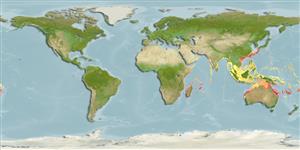Environment: milieu / climate zone / depth range / distribution range
Ekologi
marina bottenlevande; djupintervall 6 - 85 m (Ref. 86942). Tropical
Indian Ocean: Kosi Bay, South Africa (Ref. 11228) and Gulf of Martaban, Myanmar. Recently reported from the Chesterfield Islands (Ref. 11897).
Size / Vikt / Age
Maturity: Lm ? range ? - ? cm
Max length : 4.5 cm TL hane/ej könsbestämd; (Ref. 9792)
Only about the first 8 dorsal-fin rays elongate, the longest about 2.5 times head length (Ref 12933).
Feeds on small benthic animals.
Life cycle and mating behavior
Maturities | Reproduktion | Spawnings | Egg(s) | Fecundities | Larver
Hensley, D.A., 1997. Pleuronectidae. Righteye flounders. In K.E. Carpenter and V. Niem (eds.) FAO Identification Guide for Fishery Purposes. The Western Central Pacific. (Ref. 9792)
IUCN Red List Status (Ref. 130435)
Threat to humans
Harmless
Human uses
Fiskeri: saknar intresse
Verktyg
Special reports
Download XML
Internet-källor
Estimates based on models
Preferred temperature (Ref.
123201): 24.3 - 28.7, mean 27.4 °C (based on 702 cells).
Phylogenetic diversity index (Ref.
82804): PD
50 = 0.5312 [Uniqueness, from 0.5 = low to 2.0 = high].
Bayesian length-weight: a=0.01622 (0.00604 - 0.04358), b=2.94 (2.71 - 3.17), in cm total length, based on LWR estimates for this (Sub)family-body shape (Ref.
93245).
Trofisk nivå (Ref.
69278): 3.5 ±0.37 se; based on food items.
Fishing Vulnerability (Ref.
59153): Low vulnerability (10 of 100).
